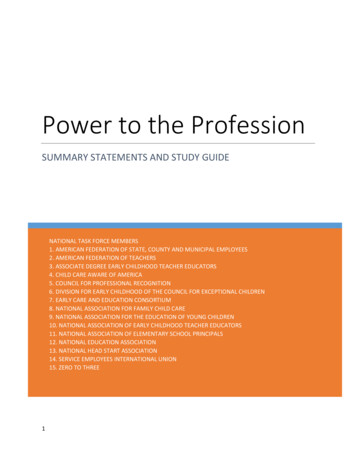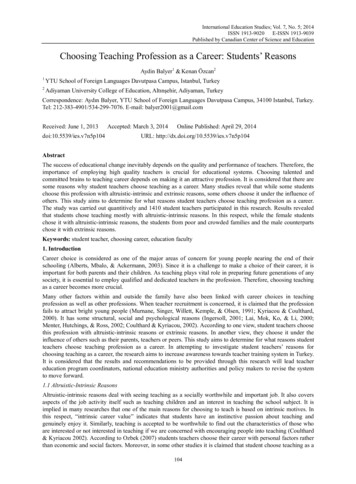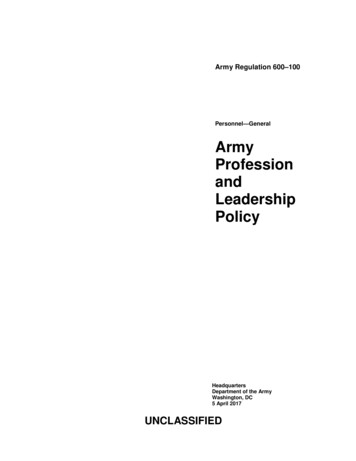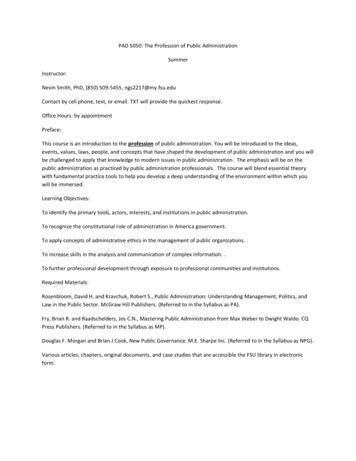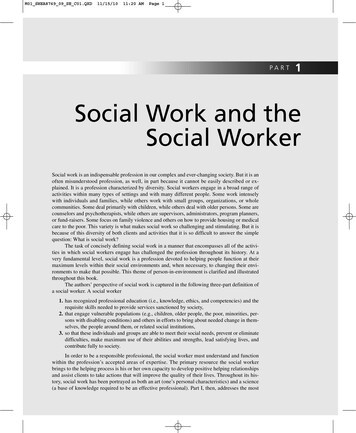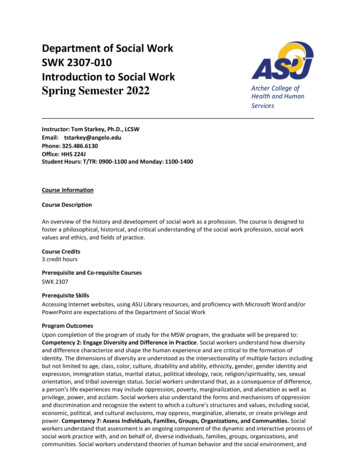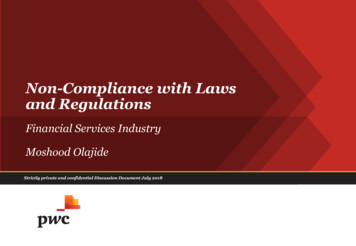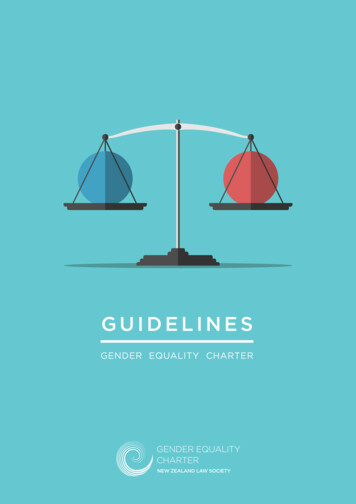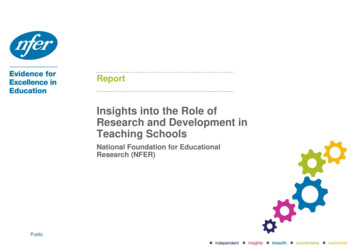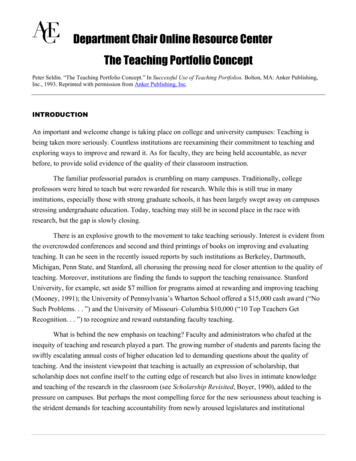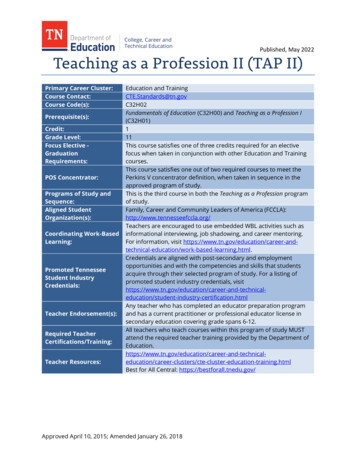
Transcription
Published, May 2022Teaching as a Profession II (TAP II)Primary Career Cluster:Course Contact:Course Code(s):Prerequisite(s):Credit:Grade Level:Focus Elective GraduationRequirements:POS Concentrator:Programs of Study andSequence:Aligned StudentOrganization(s):Coordinating Work-BasedLearning:Promoted TennesseeStudent IndustryCredentials:Teacher Endorsement(s):Required TeacherCertifications/Training:Teacher Resources:Education and TrainingCTE.Standards@tn.govC32H02Fundamentals of Education (C32H00) and Teaching as a Profession I(C32H01)111This course satisfies one of three credits required for an electivefocus when taken in conjunction with other Education and Trainingcourses.This course satisfies one out of two required courses to meet thePerkins V concentrator definition, when taken in sequence in theapproved program of study.This is the third course in both the Teaching as a Profession programof study.Family, Career and Community Leaders of America (FCCLA):http://www.tennesseefccla.org/Teachers are encouraged to use embedded WBL activities such asinformational interviewing, job shadowing, and career mentoring.For information, visit ducation/work-based-learning.html.Credentials are aligned with post-secondary and employmentopportunities and with the competencies and skills that studentsacquire through their selected program of study. For a listing ofpromoted student industry credentials, ny teacher who has completed an educator preparation programand has a current practitioner or professional educator license insecondary education covering grade spans 6-12.All teachers who teach courses within this program of study MUSTattend the required teacher training provided by the Department ducation-training.htmlBest for All Central: https://bestforall.tnedu.gov/Approved April 10, 2015; Amended January 26, 2018
Course-At-A-GlanceCTE courses provide students with an opportunity to develop specific academic, technical, and 21stcentury skills necessary to be successful in career and in life. In pursuit of ensuring every student inTennessee achieves this level of success, we begin with rigorous course standards which feed intointentionally designed programs of study.Students engage in industry relevant content through general education integration and experiencessuch as career & technical student organizations (CTSO) and work-based learning (WBL). Throughthese experiences, students are immersed with industry standard content and technology, solveindustry-based problems, meaningfully interact with industry professionals and use/produce industryspecific, informational texts.Using a Career and Technical Student Organization (CTSO) in Your ClassroomCTSOs are a great resource to put classroom learning into real-life experiences for yourstudents through classroom, regional, state, and national competitions, and leadershipopportunities. Below are CTSO connections for this course, note this is not an exhaustive list. Participate in CTSO Fall Leadership Conference to engage with peers by demonstrating logicalthought processes and developing industry specific skills that involve teamwork and projectmanagement Participate in contests that highlight job skill demonstration; interviewing skills; communityservice activities, extemporaneous speaking, and job interview Participate in leadership activities such as National Leadership and Skills Conference, NationalWeek of Service, 21st Century SkillsFor more ideas and information, visit Tennessee SkillsUSA at http://www.tnskillsusa.com and Family,Career and Community Leaders of America (FCCLA): http://www.tennesseefccla.org/Using Work-based Learning in Your ClassroomSustained and coordinated activities that relate to the course content are the key to successful workbased learning. Possible activities for this course include the following. This is not an exhaustive list. Standards 1.1-1.4 Invite an industry representative to discuss classroom management. Standards 2.1-2.3 Complete an integrated project with an industry professional. Standards 3.1-3.2 Job shadow an exceptional education class. Standards 4.1-4.5 Do a project to be used by a local industry. Standard 6.1 Have Final project evaluated by industry representatives.May 2022 Page 2
Course DescriptionTeaching as a Profession II (TAP II) is an applied-knowledge course for students interested in learningmore about becoming a teacher, school counselor, trainer, librarian, or speech-language pathologist.This course covers classroom management, concepts of higher order thinking, scaffolding instruction,and strategies of effective classroom planning. Students in this course will demonstrate their skills inlaboratory settings while building a course portfolio of work, which will carry with them throughoutthe program of study. Upon completion of this course, proficient students will be prepared to takethe capstone TAP III course and further their studies at the postsecondary level.Course Standards1. Classroom Management and Environment1.1 Behavior Policy: Research common reasons for student disobedience (e.g., unclearexpectations, desire for attention, fear, embarrassment, or lack of basic needs) and developa written behavior policy with clear positively framed expectations and consequences.1.2 Classroom Procedures: Interview one or more experienced primary and/or secondaryteachers and synthesize findings to create a checklist for performing classroom proceduresand for responding to emergency situations. The checklist should include: appropriatedaily procedures, recognizing possible child abuse and neglect, defusing violent behavior, andresponding to fire or natural disaster emergencies.1.3 Effective Classroom Layout: Research the correlation between classroom layout andeffective classroom management. Compare the use of furniture and space in severalclassrooms and analyze their compliance with both research-based recommendations foreffective classroom management and legal requirements for safety.1.4 Positive Classroom Environment: Create a rubric for evaluating a positive classroomenvironment. Include indicators such as visual appearance of the classroom, effective timemanagement, student engagement, and teacher interaction with students.2. Teaching for Higher Order Thinking2.1 Strategies that Promote Higher-Level Cognitive Skills: Investigate theories on instructionalstrategies and activities that promote the development of higher-level cognitive skills.Illustrate the alignment of Webb’s Depth of Knowledge and/or Bloom’s Taxonomy withteaching methods at each skill level.2.2 Reflection Strategies: Research various reflection strategies and demonstrate how reflectionstrategies influence academic achievement and student understanding. Develop claim(s) andcounterclaim(s) about the relationships between the use of reflection strategies, improvementof student understanding, and academic achievement.May 2022 Page 3
2.3 Cooperative and Collaborative Learning: Research the major elements of successfulcooperative/collaborative learning and their relationship to higher-order thinking skills.Design small group instructional activities incorporating those elements.3. Instructional Modifications3.1 Scaffolding: Understand when scaffolding is needed to assist students in accessing gradelevel content by analyzing individual student’s strengths and needs.3.2 Classroom Modifications: Discuss and demonstrate modifications in the classroom toaccommodate exceptional learners, including students with disabilities and those identifiedas gifted.4. Planning for Instruction4.1 Curriculum Standards: Investigate relevant national and state curriculum standards andexplain how they help guide teaching in order to affect learning.4.2 Learning Objectives and Performance Indicators: Gather and analyze Tennessee coursecontent requirements in different subject areas and grade levels. Compare and contrastexamples of student learning objectives and performance indicators from differentsubject areas and grade levels. Analyze how each provides teachers with necessaryexpectations for instruction. Choose a specific standard to rewrite for clarity andmeasurability.4.3 Design Principles: Analyze the design principles of high quality instructional materials inliteracy used in the state of Tennessee to engage students. Examples of criteria may include:a. Evidence-based practicesb. Grade-level standardsc. Progression of content or taskd. Access pointse. Content accuracyf. Student-centered4.4 Lesson Planning: Research lesson preparation in multiple grade levels and subject areas.Analyze the typical components of lesson preparation documents used in Tennessee andidentify a lesson preparation document that incorporates components such as:a. Content-area, Tennessee Academic Standards , and 21st Century Skills standardsb. Student learning objectives aligned to standardsc. Materials and equipment neededd. Instructional activitiese. Pacing chartf. Accommodations for special needs studentsg. Closure/reflectionMay 2022 Page 4
h. Assessment4.5 Group Teaching Strategies: Research and analyze individual and group teaching strategies.Make a claim about the appropriate strategy for a given situation.5. Literacy5.1 Literate Environment: Using pedagogical strategies, create a literate environment thatfosters reading by integrating foundational knowledge, use of instructional practicesapproaches and methods, curriculum materials, and appropriate use of assessment.5.2 Literacy Instruction: Implement literacy instruction and assessments that reflect anunderstanding of developmental, cultural, and linguistic diversity.5.3 Literacy Legislation: Research the legislation, policies, procedures, and resourcesimplemented in Tennessee to address literacy.6. Final Project6.1 Project: Apply knowledge from this course by demonstrating specific instructionalstrategies in a classroom situation. Document artifacts from the capstone project in thecourse portfolio. Demonstration of knowledge includes, but is not limited to, the followingactivities:a. Implement standards-based, subject-specific high-quality instructional materials forteaching students at multiple grade levelsb. Implementing standards-based lessons (created in this course) with small groups,using developmentally appropriate teaching strategies that promote student learningand higher order thinking skillsc. Selecting and using multiple types of teaching methodsd. Creating a classroom floor plan designed to provide equitable access and maximizelearning for all studentse. Evaluating student levelsf. Establishing a positive classroom climateThe following artifacts will reside in the student’s course portfolio: Lesson plans and revisions Teaching journal reflecting on lesson effectiveness, positive and negative aspects ofthe experience, self-assessment, plans for refining instructional practice Feedback from supervising teacher Revised statement of personal teaching philosophy Revised career and professional growth planStandards Alignment Notes*References to other standards include:May 2022 Page 5
P21: Partnership for 21st Century Skills Framework for 21st Century Learningo Note: While not all standards are specifically aligned, teachers will find the frameworkhelpful for setting expectations for student behavior in their classroom and practicingspecific career readiness skills.May 2022 Page 6
Teaching as a Profession II (TAP II) Primary Career Cluster: Education and Training . Course Contact: CTE.Standards@tn.gov . Course Code(s): C32H02 . Prerequisite(s): Fundamentals of Education (C32H00) and. Teaching as a Profession I (C32H01) Credit: 1 . Grade Level: 11 . Focus Elective - Graduation
